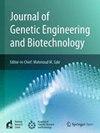Assessment of peripheral gene expression signatures as predictive biomarkers for hepatocellular carcinoma following DAA treatment
IF 2.8
Q3 Biochemistry, Genetics and Molecular Biology
Journal of Genetic Engineering and Biotechnology
Pub Date : 2025-10-08
DOI:10.1016/j.jgeb.2025.100583
引用次数: 0
Abstract
Hepatocellular carcinoma (HCC) is a major cause of cancer mortality worldwide, with viral hepatitis accounting for about 80 % of incidences. In Egypt, HCV contributes to 63 % of HCC cases. Although DAAs have achieved high SVR rates, they do not eliminate the risk of HCV-related HCC. Persistent epigenetic changes induced by HCV-infection may establish an “oncogenic memory” that promotes HCC even after viral clearance. Peripheral blood mononuclear cells (PBMCs) offer a non-invasive platform for detecting systemic immune and oncogenic signatures, aiding HCC risk assessment. This study aimed to characterize the expression of an epigenetically induced gene panel, comprising JUNB, WNT10A, SPHK1, EDN1, and KLF4 in hepatic tissues and PBMCs from Egyptian HCC patients with HCV genotype 4 who achieved SVR. In silico analyses revealed strong epigenetic associations of these genes, including links to histone-modifying enzymes, protein–protein interaction networks, and enrichment in cancer-related pathways. Gene expression was analyzed using qRT-PCR in SVR individuals, chronic HCV patients, and healthy controls, with diagnostic performance evaluated using multivariate regression and ROC curve analyses. Our results showed significant upregulation of WNT10A, SPHK1, JUNB, and EDN1 and downregulation of KLF4 in PBMCs, particularly post-SVR. PBMC expression showed high diagnostic accuracy (AUROC > 0.92 for SPHK1, WNT10A, JUNB). In conclusion, combining PBMC gene expression profiling with in-silico analyses highlights JUNB, WNT10A, SPHK1, EDN1, and KLF4 as promising non-invasive biomarker panel for HCC risk in DAA-SVR patients, reflecting their integration into epigenetic and oncogenic networks and supporting their potential for risk stratification and therapeutic targeting.
肝细胞癌DAA治疗后外周血基因表达特征作为预测性生物标志物的评估
肝细胞癌(HCC)是全球癌症死亡的主要原因,其中病毒性肝炎约占80%的发病率。在埃及,丙型肝炎病毒占HCC病例的63%。尽管daa已达到较高的SVR率,但它们并不能消除hcv相关HCC的风险。由丙型肝炎病毒感染引起的持续表观遗传改变可能建立一种“致癌记忆”,即使在病毒清除后也能促进HCC的发生。外周血单个核细胞(PBMCs)为检测全身免疫和致癌特征提供了非侵入性平台,有助于HCC风险评估。本研究旨在表征表观遗传诱导的基因组,包括JUNB, WNT10A, SPHK1, EDN1和KLF4在实现SVR的埃及HCV基因型4 HCC患者的肝组织和PBMCs中的表达。计算机分析揭示了这些基因的强表观遗传关联,包括与组蛋白修饰酶、蛋白质相互作用网络和癌症相关途径中的富集的联系。采用qRT-PCR分析SVR个体、慢性HCV患者和健康对照的基因表达,并采用多变量回归和ROC曲线分析评估诊断效果。我们的研究结果显示WNT10A、SPHK1、JUNB和EDN1在pbmc中显著上调,KLF4下调,尤其是在svr后。PBMC表达具有较高的诊断准确性(SPHK1、WNT10A、JUNB的AUROC >; 0.92)。总之,结合PBMC基因表达谱和计算机分析,JUNB、WNT10A、SPHK1、EDN1和KLF4是DAA-SVR患者HCC风险的有前途的非侵入性生物标志物,反映了它们与表观遗传和致癌网络的整合,并支持它们在风险分层和治疗靶向方面的潜力。
本文章由计算机程序翻译,如有差异,请以英文原文为准。
求助全文
约1分钟内获得全文
求助全文
来源期刊

Journal of Genetic Engineering and Biotechnology
Biochemistry, Genetics and Molecular Biology-Biotechnology
CiteScore
5.70
自引率
5.70%
发文量
159
审稿时长
16 weeks
期刊介绍:
Journal of genetic engineering and biotechnology is devoted to rapid publication of full-length research papers that leads to significant contribution in advancing knowledge in genetic engineering and biotechnology and provide novel perspectives in this research area. JGEB includes all major themes related to genetic engineering and recombinant DNA. The area of interest of JGEB includes but not restricted to: •Plant genetics •Animal genetics •Bacterial enzymes •Agricultural Biotechnology, •Biochemistry, •Biophysics, •Bioinformatics, •Environmental Biotechnology, •Industrial Biotechnology, •Microbial biotechnology, •Medical Biotechnology, •Bioenergy, Biosafety, •Biosecurity, •Bioethics, •GMOS, •Genomic, •Proteomic JGEB accepts
 求助内容:
求助内容: 应助结果提醒方式:
应助结果提醒方式:


